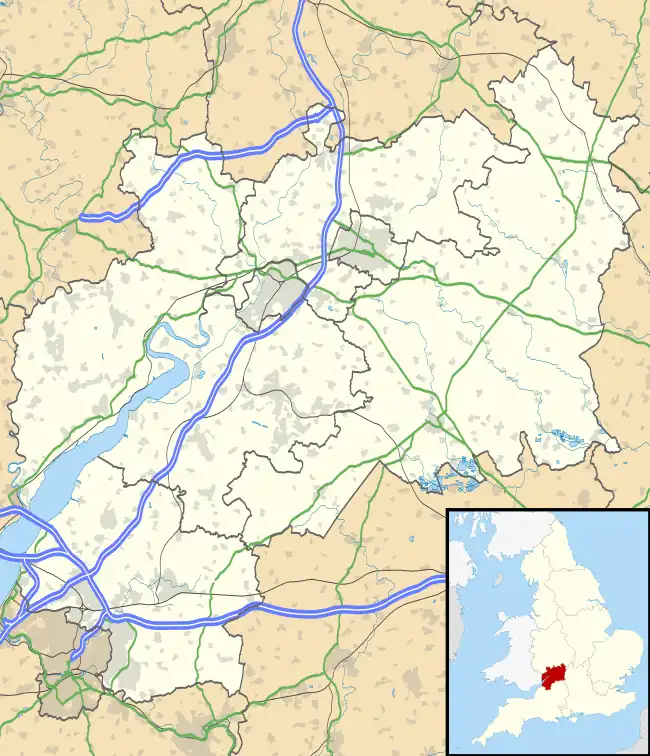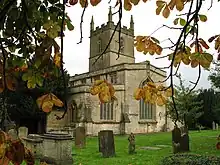| Stow-on-the-Wold | |
|---|---|
 Market Square | |
 Stow-on-the-Wold Location within Gloucestershire | |
| Population | 2,042 (2011 Census)[1] |
| Civil parish |
|
| District | |
| Shire county | |
| Region | |
| Country | England |
| Sovereign state | United Kingdom |
| Post town | CHELTENHAM |
| Postcode district | GL54 |
| Dialling code | 01451 |
| Police | Gloucestershire |
| Fire | Gloucestershire |
| Ambulance | South Western |
| UK Parliament | |
Stow-on-the-Wold is a market town and civil parish in Gloucestershire, England, on top of an 800-foot (244 m) hill at the junction of main roads through the Cotswolds, including the Fosse Way (A429), which is of Roman origin. The town was founded by Norman lords to absorb trade from the roads converging there. Fairs have been held by royal charter since 1330; a horse fair is still held on the edge of town nearest to Oddington in May and October each year.
History
Early
Stow-on-the-Wold, originally called Stow St Edward or Edwardstow after the town's patron saint Edward, probably Edward the Martyr,[2] is said to have originated as an Iron Age fort on this defensive position on a hill. Indeed, there are many sites of similar forts in the area, and Stone Age and Bronze Age burial mounds are common throughout the area. It is likely that Maugersbury was the primary settlement of the parish before Stow was built as a marketplace on the hilltop nearer to the crossroads, to take advantage of passing trade. Originally the small settlement was controlled by abbots from the local abbey, and when the first weekly market was set up in 1107 by Henry I, he decreed that the proceeds go to Evesham Abbey.[2]

In 1330, a royal charter by Edward III set up an annual 7-day market to be held in August. The royal charter granted a fair where sheep and horses were allowed to be sold.[2][3] In 1476, Edward IV replaced that with two 5-day fairs, two days before and two days after the feast of St Philip and St James in May, and similarly in October on the feast of Edward the Confessor (the saint associated with the town). The aim of the annual charter fairs was to establish Stow as a place to trade and alleviate the unpredictability of the passing trade. These fairs were located in the square, which is still the town centre.[2]
Civil war
Stow played a role in the English Civil War. A number of engagements took place in the area, the local church of St Edward being damaged in one skirmish. On 21 March 1646, the Royalists, commanded by Sir Jacob Astley, were defeated at the Battle of Stow-on-the-Wold, with hundreds of prisoners being confined for some time in St Edwards.[4] This battle took place one mile north of Stow-on-the-Wold. After initial royalist success, the superiority of the parliamentary forces overwhelmed and routed the royalist forces. Fleeing the field, the royalists fought a running fight back into the streets of Stow, where the final action took place, culminating in surrender in the market square.[5]
Modern
As the fairs grew in fame and importance, so did the town. Traders dealing in livestock added many handmade goods, and the wool trade was always prominent.[6] Daniel Defoe reported in the 18th century that 20,000 sheep were sold in one day.[3] Many alleys known as 'tures' that run between buildings into the market square were used in herding sheep to be sold.[7] From the mid-19th century, the Talbot Hotel was the venue for corn merchants carrying out their trade.[8]
Most of the buildings around the market square dated from the 18th to 19th century including St Edward's Hall (the present-day library).[3]
As the wool trade declined, people began to trade in horses. The practice continues, although the fair has been moved from the square to a large field near the village of Maugersbury every May and October. It remains popular, with roads around Stow blocked by the extra traffic for many hours.[9]
However, there has been controversy surrounding Stow Fair. The many visitors and traders have attracted more vendors not dealing in horses. Local businesses used to profit from the increased custom, but in recent years most pubs and shops close for 2–3 miles around due to the risks of theft or vandalism.[10]
Governance
The town belongs to the Stow electoral ward, which covers the parishes of Stow-on-the-Wold, Maugersbury and Swell. In 2010 these parishes had a total population of 2,594.
Stow-on-the-Wold has an active Parish Council with 10 members.[11]
Stow-on-the-Wold ward is represented on Cotswold District Council by the Liberal Democrat Councillor Dr. Dilys Neill, who was first elected in the 2016 local elections.[12] The Stow Division is represented on Gloucestershire County Council by the Conservative Councillor Mark Mackenzie-Charrington.[13]
Stow Ward
| Party | Candidate | Votes | % | ±% | |
|---|---|---|---|---|---|
| Liberal Democrats | Dilys Neill | 577 | 65.3 | +21.4 | |
| Conservative | Tom Bradley | 307 | 34.7 | -21.4 | |
| Majority | 270 | 12.2 | |||
| Turnout | 42.7 | ||||
| Liberal Democrats gain from Conservative | Swing | ||||
Gloucestershire County Council
| Party | Candidate | Votes | % | ±% | |
|---|---|---|---|---|---|
| Conservative | Nigel Moor | 2,340 | 63 | ||
| Liberal Democrats | Rachel Coxcoon | 1,014 | 27 | ||
| Green | Andrew Maclean | 210 | 6 | ||
| UKIP | Edeltraud French | 139 | 4 | ||
| Majority | 1,326 | ||||
| Conservative hold | Swing | ||||
Economy
Scotts of Stow, a mail order company, also has two shops in the town.[14]
Media
Local news and television programmes are provided by BBC South and ITV Meridian. Television signals are received from the Oxford and local relay transmitters. [15] [16]
Local radio stations are BBC Radio Gloucestershire, Heart West, Greatest Hits Radio South West and Cotswolds Radio, community based radio station [17]
The town is served by the local newspaper, Cotswold Journal. [18]
Popular culture

- Given its exposed spot on the top of Stow Hill, the town is often referred to as "Stow on the Wold, where the winds blow cold."[19]
Stow-on-the-Wold, Where the wind blows cold.
Where horses young and old are sold,
Where farmers come to spend their gold,
Where men are fools and women are bold,
And many a wicked tale is told.High on the freezing Cotswold.
- Stow-on-the-Wold featured prominently in the eleventh episode of series 6 of Top Gear, when Jeremy Clarkson reviewed the Ford F-Series there. He chose it as a venue because it is a typical community in the English countryside, which Clarkson compares to the American countryside in the episode.[20]
Transport
The following roads pass through the town:
- The Fosse Way (A429) runs from the M4 motorway, just north of Chippenham, to the M40 motorway at Warwick
- The A424 links the town centre to the A44, near Bourton-on-the-Hill, which continues to Evesham
- The A436 connects Brockworth with Salford, Oxfordshire.
From 1881 until 1962, the town was served by Stow-on-the-Wold railway station on the Great Western Railway's Banbury and Cheltenham Direct Railway. The nearest station is now at Moreton-in-Marsh, which is 4 miles (6.4 km) away, on the Cotswold Line between Hereford and London Paddington; services are provided by Great Western Railway. An alternative is at Kingham, 5 miles (8.0 km) away from Stow on the same line.[21]
Local bus services are operated predominantly by Pulhams Coaches; key routes that serve the town lead to Moreton-in-Marsh, Hook Norton and Bourton-on-the-Water.[22]
Notable people
- Clement Barksdale (1609–1687), writer and poet, was Rector of Stow-on-the-Wold from 1660 to 1687.
- Edmund Chilmead (1610–1654), writer, translator and musician, was born in the town.
- George Wilkinson (1814–1890), was the architect of Stow-on-the-Wold Workhouse in 1836.
- George Pepall (1876–1953), county cricketer, was born in the town.
- Harry Ferguson (1884–1960), engineer and inventor of the Ferguson tractor, died in the town.
- Frederic Bartlett (1886–1969), experimental psychologist and academic, was born in the town.
- John Howland (1895–1958), county cricketer, was born in the town.
- John Entwistle (1944–2002), musician, producer and bass guitarist of the Who, bought Quarwood in Stow-on-the-Wold in 1976. His funeral was held at St Edward's Church.
- David Loder (born 1964), racehorse trainer, was born in the town.
References
- ↑ "Parish population 2011". Office for National Statistics. Archived from the original on 2 April 2015. Retrieved 22 March 2015.
- 1 2 3 4 Elrington, C. R., ed. (1965). "Parishes: Stow-on-the-Wold". A History of the County of Gloucester: Volume 6. London: Institute of Historical Research. pp. 142–165. Archived from the original on 10 May 2009. Retrieved 23 September 2008 – via British History Online.
- 1 2 3 Elder, David (15 July 2015). 50 Gems of the Cotswolds: The History & Heritage of the Most Iconic Places. Amberley Publishing Limited. ISBN 978-1-4456-4671-8.
- ↑ Bingham, Jane (18 February 2010). The Cotswolds: A Cultural History. Oxford University Press. pp. 58–. ISBN 978-0-195398755. Retrieved 1 December 2012.
- ↑ "Battle of Stow-on-the-Wold (1646)". Battlefields of Britain. Archived from the original on 29 August 2019. Retrieved 21 July 2020.
- ↑ "Stow on the Wold". Cotswolds Info. Archived from the original on 11 May 2020. Retrieved 21 July 2020.
- ↑ "A Brief History". Stow on the Wold Town Council. Archived from the original on 24 July 2011. Retrieved 28 May 2013.
- ↑ Historic England. "The Talbot Hotel (and rear extensions) (1088797)". National Heritage List for England. Retrieved 25 July 2023.
- ↑ "Stow Horse Fair". Calendar Customs. Archived from the original on 29 May 2018. Retrieved 21 July 2020.
- ↑ "Tearoom bouncers tackle fair fear". BBC News. 20 October 2005.
- ↑ "Stow Town Council Members". Stow-on-the-Wold Town Council. Archived from the original on 28 June 2018. Retrieved 28 June 2018.
- ↑ "Dilys Neill". Cotswold District Council. Retrieved 17 June 2023.
- ↑ "Cllr Nigel Moor FRTPI FRSA". Gloucestershire County Council. Archived from the original on 31 October 2019. Retrieved 21 July 2020.
- ↑ "Home". Scotts of Stow. Retrieved 18 August 2020.
- ↑ "Full Freeview on the Oxford (Oxfordshire, England) transmitter". UK Free TV. 1 May 2004. Retrieved 5 October 2023.
- ↑ "Freeview Light on the Icomb Hill (Gloucestershire, England) transmitter". UK Free TV. 1 May 2004. Retrieved 5 October 2023.
- ↑ "Cotswolds Radio". Retrieved 5 October 2023.
- ↑ "Cotswold Journal". British Papers. 19 March 2014. Retrieved 5 October 2023.
- ↑ "Stow-on-the-Wold". Cotswolds Guide. Archived from the original on 22 August 2018. Retrieved 21 July 2020.
- ↑ Archer, Megan (15 May 2014). "Top Gear trio Jeremy Clarkson, Richard Hammond and James May drive into Stow-on-the-Wold to film new series". Wilts and Gloucestershire Standard. Retrieved 21 July 2020.
- ↑ "Train Times". Great Western Railway. 21 May 2023. Retrieved 14 October 2023.
- ↑ "Stops in Stow-on-the-Wold". Bus Times. 2023. Retrieved 14 October 2023.